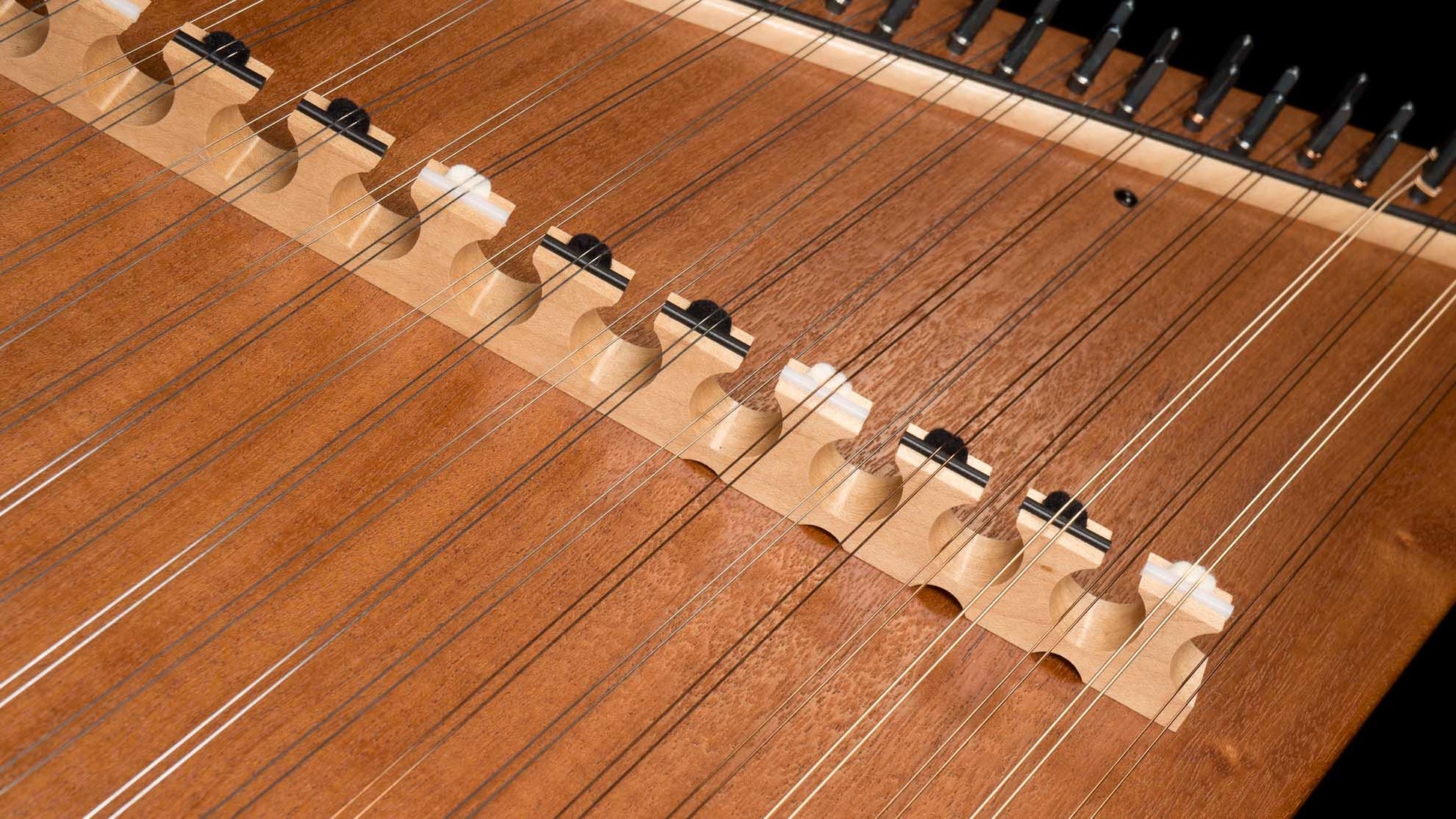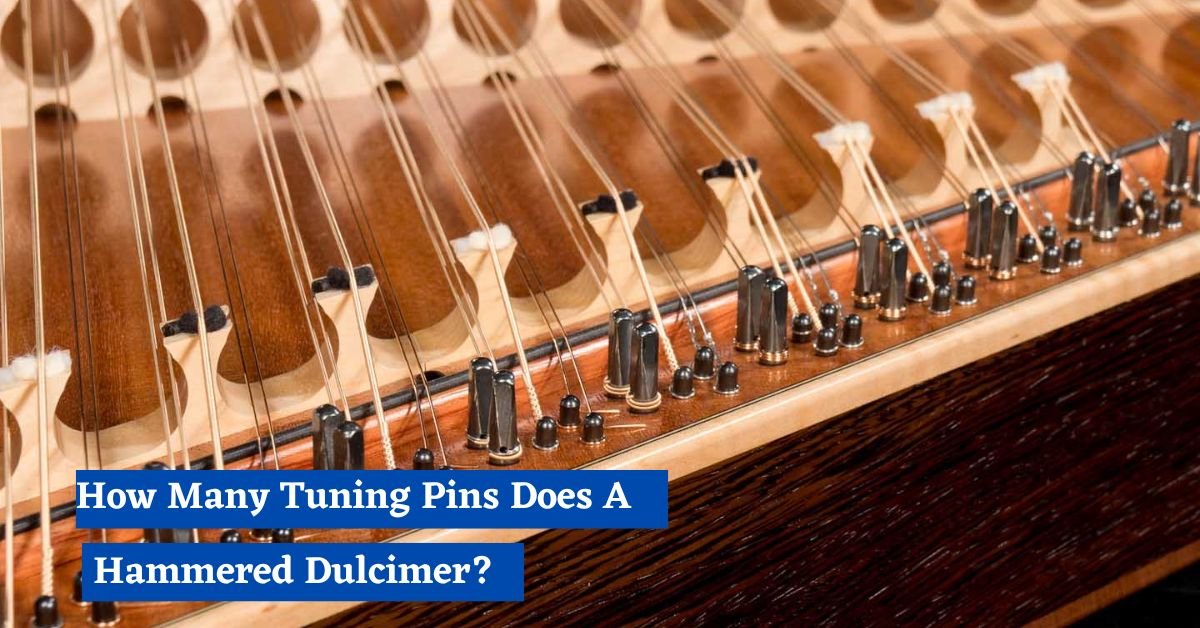How Many Tuning Pins Does A Hammered Dulcimer: A hammered dulcimer typically has around 70 to 100 tuning pins, depending on its size and design.
The Anatomy of a Hammered Dulcimer
- The Soundboard: This is the large, flat, wooden surface that serves as the primary resonating element of the dulcimer. When the strings are struck with hammers, the soundboard vibrates, amplifying and projecting the sound.
- The Bridges: These are small wooden pieces that support and elevate the strings above the soundboard. Hammered dulcimers usually have multiple bridges, dividing the strings into different courses.
- The Strings: The strings run across the soundboard and are typically made of steel or other materials. They are attached to tuning pins on one end and to hitch pins on the other.
- The Tuning Pins: These are metal pins that are embedded into the pin block, located on the side or back of the hammered dulcimer. They hold the strings in place and allow for tuning adjustments.
- The Pin Block: This is a dense wooden block into which the tuning pins are tightly fitted. It provides stability and resistance to the tension of the strings.
The Number of Tuning Pins on a Hammered Dulcimer
Hammered dulcimers can vary in size, design, and the number of strings they possess, which ultimately affects the number of tuning pins they have. A standard hammered dulcimer typically has between 60 to 100 strings. The number of tuning pins, therefore, corresponds to the number of strings. Each string has its tuning pin, which can be tightened or loosened to adjust the pitch of the individual string.

For instance, a typical hammered dulcimer with 78 strings will have 78 tuning pins, one for each string. More strings mean a higher range and potentially more complex musical arrangements, while fewer strings might be favored by those seeking a more simplistic, traditional sound.
The Role of Tuning Pins in Hammered Dulcimer
Tuning pins play a critical role in maintaining the hammered dulcimer’s sound quality and versatility. Since each string has its tuning pin, musicians can individually adjust the tension of each string. This allows them to alter the pitch of the string, enabling them to play different musical scales, modes, and tunings. The ability to fine-tune each string is what makes the hammered dulcimer such a versatile instrument, capable of adapting to various musical styles and arrangements.
Additionally, tuning pins need to be durable and firmly anchored to the pin block to withstand the tension from the tightened strings. High-quality tuning pins are crucial for keeping the dulcimer in tune and ensuring it can withstand the physical demands of regular playing.
Common Tuning Techniques for Hammered Dulcimer
- Equal Temperament Tuning: This is the most common tuning method used in western music. It divides the octave into twelve equal semitones, allowing musicians to play in any key without the need for constant retuning. This tuning is preferred in many contemporary music genres.
- Just Intonation Tuning: This tuning method uses whole number ratios to create pure and harmonious intervals. Just intonation is often favored in traditional and folk music styles for its natural and authentic sound.
- Modal Tuning: In this technique, the dulcimer is tuned to a specific musical mode, such as Dorian, Mixolydian, or Lydian. Modal tuning creates a distinct tonal quality and is commonly used in Celtic and Middle Eastern music.
Tunings on a Hammered Dulcimer
On a hammered dulcimer, there are various tunings that musicians can use to create different musical moods and styles. Some common tunings include the Ionian (Major) tuning, Mixolydian tuning, Dorian tuning, and the Chromatic tuning.

Each tuning alters the arrangement and pitch of the strings, allowing players to explore diverse scales and modes. The choice of tuning depends on the musical genre and the desired emotional expression. Experimenting with different tunings adds depth and richness to the hammered dulcimer’s sonic palette, making it a versatile instrument for musicians to explore.
Number of Strings on a Hammered Dulcimer
A hammered dulcimer typically has a range of 60 to 100 strings. The number of strings can vary depending on the size and design of the instrument. Each string is attached to its tuning pin, allowing for individual adjustment of the pitch.
The greater the number of strings, the broader the instrument’s musical range, enabling musicians to create intricate melodies and harmonies. More strings offer increased versatility and complexity in musical arrangements, while dulcimers with fewer strings might be favored by those seeking simplicity and a more traditional sound.
Standard Tuning for a Hammered Dulcimer
The standard tuning for a hammered dulcimer is often referred to as the Ionian or Major tuning. In this tuning, the strings are arranged in a diatonic scale, starting from a specific note (commonly C or D) and ascending in whole steps, with the exception of half steps between the third and fourth, and seventh and eighth notes of the scale. The standard tuning provides a bright and familiar sound, making it a popular choice for various musical genres, including folk, classical, and contemporary music. However, it’s important to note that different players may have personal preferences for tuning variations.
How to Tune a 4-String Dulcimer
Tuning a 4-string dulcimer requires attention to detail and a keen ear for pitch. Here’s a step-by-step guide to tuning the instrument:
- Choose the Desired Pitch: Determine the desired pitch for each string. Common tunings include D-A-D-G or D-G-D-G.
- Get a Tuning Device: Use an electronic tuner, pitch pipe, or a reliable tuning app to assist in achieving accurate pitch.
- Start with the Bass String: Begin tuning the lowest-pitched string, which is usually the thickest string (bass string). Adjust the tuning peg until the string matches the desired pitch.
- Tune the Remaining Strings: Move to the next strings, tuning them according to the chosen tuning. Ensure each string is in tune with the reference pitch.
- Check and Fine-Tune: After all strings are tuned, play some chords and notes to check for accuracy. Make any necessary adjustments using the tuning pegs.
Tuning a 4-string hammered dulcimer may require some practice, but with patience and persistence, achieving the desired tuning is achievable for players of all levels.
FAQs
Can I tune a hammered dulcimer like a piano?
While both instruments use tuning pins, the tuning process differs significantly. Hammered dulcimers have multiple strings and require individual tuning, whereas pianos have strings grouped in sets and are tuned to specific pitches in a more standardized manner.
How often should I tune my hammered dulcimer?
The frequency of tuning depends on several factors, including the environmental conditions, the quality of the tuning pins and strings, and how often you play the instrument. In general, it’s a good idea to tune your dulcimer before each practice or performance and periodically throughout the year.
Can I replace broken or worn-out tuning pins?
Yes, tuning pins can be replaced if they become damaged or worn out. It is best to seek assistance from a professional luthier or instrument technician for proper replacement and installation.
Conclusion
The hammered dulcimer’s enchanting sound and versatility have made it a cherished instrument across various musical genres. Understanding its anatomy, particularly the tuning pins, provides valuable insight into how musicians can create the instrument’s distinct tones and adapt it to different playing styles. With a wide range of strings and tuning options, the hammered dulcimer offers endless possibilities for musical expression, making it a timeless treasure in the world of music.


